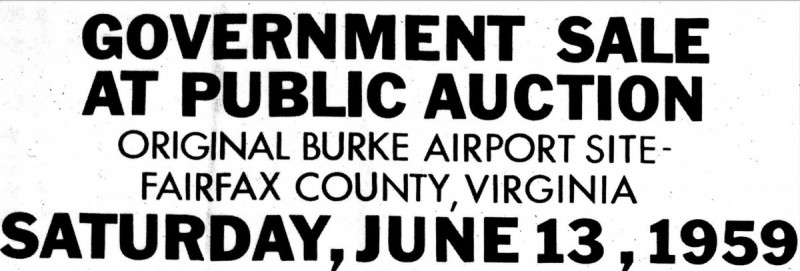Dulles Airport was originally supposed to be in Burke, but neighbors successfully stopped it

Map of proposed site from the Evening Star on June 14, 1951.
Three generations of DC area residents have grown up associating Dulles Airport with its Chantilly location. However, Dulles could have been located in Burke, were it not for a grassroots effort that convinced President Eisenhower to choose another site.
In June 1941, Washington National Airport opened in Arlington on reclaimed land from Gravelly Point. It replaced Washington-Hoover Airport, which was located just north of the new airport, on what today is the Pentagon.
But by 1950, Washington National was struggling with the amount of traffic from new, larger commercial airplanes. That year, Congress passed the Washington Airport Act for “… the construction, protection, operation, and maintenance of a public airport in or in the vicinity of the District of Columbia.” This new airport would be built on a much larger plot of land than its predecessors to accommodate the larger, jet-powered airplanes.
Seven locations were considered for the new airport, including Friendship Airport (which is BWI today), Andrews Air Force Base in Maryland, and the Willard area, located at the west end of Fairfax County. But in June 1951, the residents of the small town of Burke in Fairfax County began receiving notices that their land had been condemned by the U.S. Government.
Local resident Suzi Neal remembers the day notice was given to her family. “It wasn’t a choice,” she was quoted as saying in “Braddock’s True Gold,” a history of the area. “It was condemned. It was taken. President Eisenhower said there will be an airport in Burke.”
Overlay of Burke and Springfield today with the proposed location of the airport and access road. Image by the author.
The day after the Neals received their notice, local newspaper the Evening Star described the 4,500-acre site as a “super airport which will dwarf both Washington National and Baltimore’s Friendship terminals.” The airport was slated to begin construction in 1952 and be completed in 1955.
Neal explained the federal government’s reasoning for putting the airport in Burke. “[The Government] had reached so much opposition in the neighboring communities that they thought Burke was a little sleeping town, that they’d put it here, and they’d get—they’d do it.” Meanwhile, the government began acquiring parcels of land for their airport. Large farms were being bought up with 100-acre farms being purchased for $19,000 (about $180,000 in 2017 dollars). Despite the start of land acquisition to move the project forward, the citizens began fighting back.
Following the receipt of the government notices, three hundred local citizens gathered and formed the Burke Civic Association. Jones Jasper, a Burke farmer, filed multiple junctions against the project in District Court.
One permanent injunction was filed to block the airport from building within 12,500 feet of his 100-acre farm. The suit alleged potential harm caused from airport operations, including “frequent operation of large, heavy, powerful multi-engined civil aircraft over plaintiff’s property at an altitude below the navigable air space…would constitute a continuing trespass on his property…and endanger persons and animals.”
One local resident was as an editor for the Washington Post, and provided a conduit to get out stories about of the locals affected. One story was on a small black community within the land to be condemned. It focused on an elderly lady within the community that was a former slave and how she didn’t want to lose the land that General Ulysses S. Grant gave her.
Faced with delays to starting the construction process and the rapid expansion of the suburbs, President Eisenhower revisited the site selection process. Eisenhower’s special adviser on aviation, retired Lt. Gen. Elwood R. “Pete” Quesada, advised him to select the Willard area, in the western part of Fairfax County.
Willard offered more land mainly from farms at cheaper prices that was further from the urban sprawl that was underway in Burke. The small Blue Ridge Airport was also located a mile north of Willard’s main crossroads. The president agreed, and condemnation letters were sent to 87 landowners to acquire 9,800 acres for the new airport.
Though residents of the largely African-American community tried to band together to fight the airport, unlike the well-connected Burke, their efforts failed. Within four years, the $110 million construction project was complete and Dulles Airport opened in 1962. Top of GSA Flyer advertising the sale of condemned properties. Image by GSA.

Eight years after locals received the initial notification that the government had condemned their homes. the GSA now had to liquidate the unneeded land. 888 acres at the south end of the site were turned over to Fairfax County to create Burke Lake Park. The remaining plots were auctioned off in June of 1959, and many of them were consolidated in 1977 to create the planned community of Burke Centre. This community was a mixture of homes, businesses, and industry spread over 1,250 acres and connected by nature trails and outdoor spaces.
Looking back at the struggle to stop the Burke airport, Neal summed up the efforts of the locals in a way that might sound familiar to today’s activists. “They beat it by having people in the community call their family, call their friends, call their relatives, call your neighbors,” she said. “Have them write your Congressman and ask them to vote against the Burke Airport.” Faced with the impossible task, this self-described sleepy town managed to come together and defeat the most powerful men in the country.
